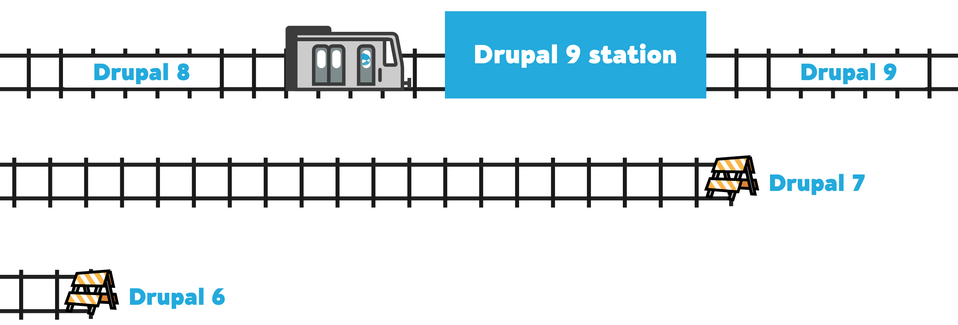
Drupal 8 End of Life. What Does This Mean For your Website?
The end has come! It may not be final, actually, but it's definitely quite relevant and meaningful considering Drupal's long way. We said goodbye to our reliable and beloved Drupal 8. When did it happen and what does it entail?
Drupal 8 - version history
Drupal 8 was released on 19 November 2015. It was a big and bold step in the development history of this CMS. Drupal 8 from the very beginning was announced as a revolution and an ambitious approach of its creators to the subject. Compared to the older version, practically everything has changed, except for the general assumptions of the system. The users who had previously used version 7 faced a change that could hardly be described as smooth and simple.
Looking from the code level, Drupal 7 and 8 are in fact two different creations that, apart from the name, have very little in common. Upgrading to version 8 in many cases meant rebuilding the website from scratch. Today, after many years and the experience gained associated with it, it's a slightly less burdensome process because where the need arises, there will always be solutions at hand.
Drupal 8 can certainly be described as a thick line that separates the past from the future. It was perhaps the most important moment in the history of this CMS, setting the course for the future.
Drupal core
Drupal has been rewritten using the well-known and liked Symfony framework. In practice, this meant that - apart from having a similar body - there was a completely new engine under the hood. The previous versions of Drupal weren’t based on any of such well-known and elaborate frameworks. The change affected a much larger number of Drupal elements, particularly the template engine. From the moment Drupal 8 appeared, it was TWIG (which was a consequence of using the Symfony framework, also implementing this solution). It made it easy and comfortable to create templates, abandoning the earlier obsolete technologies.
The creators of the new version introduced the Views module to the Drupal core, which allows for downloading the content from your website database and displaying it to the viewer in the form of posts, menu items, galleries or blocks. In addition, almost 200 changes and fixes appeared with the release of Drupal 8.
Contributed modules
What would an open source system be without community support? It's the people, their work and contribution to the development of such systems that constitute the backbone of each one of them. Therefore, I'll now present to you some interesting modules created by the Drupal community that I had the pleasure of using in Drupal 8. Let's consider it a small homage paid to the creators involved in the development of our favourite CMS.
- Security Kit, Security Review, Hacked! - support in securing our website against attacks.
- GoogleTagManager, Google Analytics - integration of our page with Google tools.
- Captcha - securing forms with various types of captchas.
- Backup and Migrate - creating backup copies of the system.
- Linkit - management of internal and external linking on your page.
- Pathauto - managing addresses and aliases on your website.
- Scheduler - scheduling the publication of your content.
- Paragraph View Mode - creating view modes for paragraphs.
Drupal 8 EOL - important information
The support for Drupal 8 ended on 2 November 2021. What does it actually mean? First of all, you should remember about the necessity of having up-to-date versions of the software. Newer versions in most cases mean a safer system devoid of security holes.
Drupal 8 support end date
With the end of developer support, which was on 2 November 2021, no more official updates will be released. The developers also finished works related to the improvement and maintenance of the system. From now, you can count only on your own and the Drupal community that may or may not support the system unofficially. Should you start to panic now? Of course not! Drupal is alive and well, and the new version (Drupal 9) is still being developed and supported. Therefore, the only thing you need to do is join the ranks of the lucky ones whose systems are already running on version 9.
Drupal 9
The king is dead, long live the king - we should allow Drupal 8 for a well-deserved retirement. It's time to welcome the present and learn about the benefits of Drupal 9. What actually is this version and what has it introduced? It is largely a development of what Drupal 8 has brought. You could call it cleaning up the code from the Drupal 7 leftovers. Don't expect a revolution like Drupal 8 here (rest assured, there'll be time for this). Drupal 9 is a rather small step into the future and the closure of a very important chapter in the history of our favourite CMS.

Source: Drupal.org
Upgrade process
The process of upgrading to Drupal 9 is closely related to your current version of the system. In the case of Drupal 7, you'll hit the same wall that users met when switching from 7 to 8. The transition from Drupal 8 to 9 should be much simpler and partially automatic, although it requires some basic technical knowledge. You can also use a Drupal support service to make sure that the process goes smoothly.
Drupal 8 end of life - summary
This is the end - with these words by Jim Morrison we say goodbye to our friend. Although it's painful, it's time too for Drupal 8 to be put on the shelf where it can deservedly rest next to its predecessors. For many of us (including me), it was probably the first contact with Drupal, which makes it an even more significant event. This is a good time to reminisce about the good things and look to the future, which promises to be amazing.











